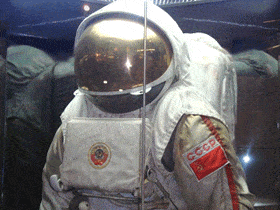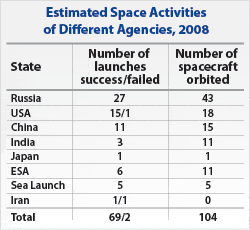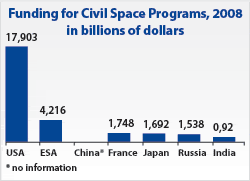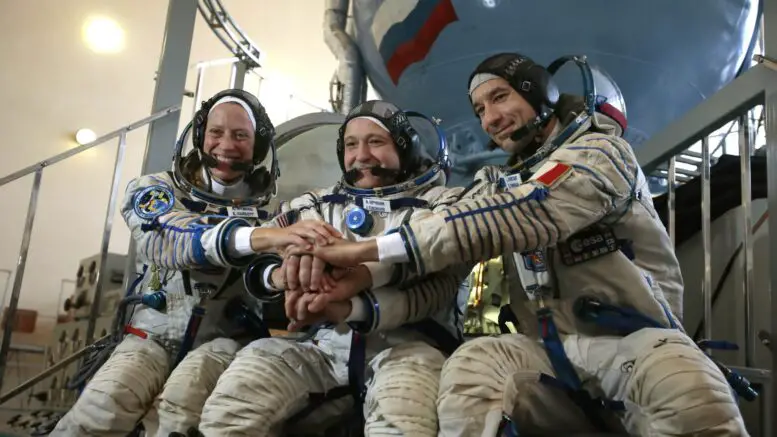
A Soviet-era space suit. This picture was taken by Tabitha Smith at the Memorial Museum of Cosmonautics in Moscow.
Humanity’s space age had its beginnings in the Cold War rivalries between the US and the USSR. Both countries attempted to advance their own sciences and show the world that their national ideology could lead mankind to a better future faster. Space exploration has since become a model of international cooperation, where countries including Russia and the US share information and coordinate projects together. It is, however, still a source of great pride to Russia and a field in which Russia excels.
Brief History of the Space Race
Sputnik, which literally means “satellite” in Russian, was the first man-made object to orbit earth and arguably the beginning of the space race. The fact that the Soviets had the capability of launching a satellite meant they potentially had the rocket technology to launch a nuclear bomb that could reach America. The US had long considered itself the world leader in technology and weaponry. The Soviet achievement shocked the American government and spurred a wave of investment by the US government in science, education, and space exploration. Despite America’s efforts, the Soviets held the lead for some time.
Sputnik was not only meant to orbit the earth, but also to open the door to further exploration by collecting information about conditions in low earth orbit including atmospheric density, temperature, and the prevalence of meteors. It collected data via a range of instrumentation and transmitted it via radio signals.
The success of Sputnik was followed by a string of other achievements by the Soviets. In November of 1957, just a month after the first Sputnik launch, Sputnik-2 carried Laika into orbit. Laika was a dog whose Russian name translates roughly as “Barker” (though the Americans satirically dubbed her Mutt-nik). She was the first living organism from Earth to enter space. Data from this experiment was later used to launch the first man, Soviet Cosmonaut Yuri Gagarin, into orbit in 1961. In 1965, the Soviets sent Alexei Leonov to perform mankind’s first space walk.
The Americans “caught up” in 1969, when the Apollo Program landed the first man on the moon.
The race, however, didn’t end there, as the Soviets placed the first space station in orbit in 1971. Known as “Salyut,” meaning “salute,” “salutations,” or “fireworks” in Russian, the station was a small single-module structure. The first multi-module space station meant for consistent, long term inhabitation was the equally richly named Mir (meaning “world,” “community,” or “peace”), which was launched by the USSR in 1986 and completed in space in 1996.
The Americans also had their own plans to build a space station as well as a space-based missile defense system dubbed the “Star Wars” program. The Soviets, in part as a response to the Star Wars program, planned to build Mir 2, a larger and more complex station that would give them an even greater space presence.
These grand plans would be truncated due largely to the fall of the Soviet Union. In the political and economic turmoil that followed, Russia was in no position to continue such expensive projects. The US Congress, which had largely seen the space race as a competition of ideologies, also lost the resolve to continue supporting the programs. Congress voted down a bill to fund an American space station and the Star Wars program was deemed too scientifically and politically complicated to implement.
The plans for a space station, however, were not cancelled. Space technology would become one of the first areas in which the US and Russia declared an open partnership, merging their plans and resources to create the International Space Station (ISS) together with several other countries.

A Soyuz rocket awaiting liftoff at the Baikanour Cosmodrome. Soyuz rockets have been a staple of space flight since the 1960s. Picture originally published by the Boston Globe.
The Vostochny Project
After mid-2010, Russia will be the world’s only link to the ISS, as the US plans to retire its current shuttle program. NASA’s new program, Constellation, will launch its first craft in 2015. Russia itself, however, is dependent on Kazakhstan, the former Soviet republic where the main Soviet launch pad was built, to make its launches. Russia rents the complex, known as Baikonur, for $115 million per year.
As part of its long-term plans, Russia will build a new launch site on its own soil that will take over all of Russia’s human space launches and most commercial satellite launches. The new site has been dubbed “Vostochny,” meaning “Eastern,” as it will be in Russia’s Far East. The plans, which are still tentative, call for some fifty new facilities, including a new cosmonaut training center, an airfield, an “akademgorodok” (a large scientific research and residential complex), a new presidential compound, and a vast amount of housing for those who will staff these facilities. Currently, the favored site for the project is in Russia’s Amur Oblast, near the small town of Uglegorsk.
“Uglegorsk” translates as “Coal Mountain,” but in fact is not near any coal reserves. It was likely given its innocuous name to mask the fact that it was built as part of a top-secret missile base known as “Svobodny” (which means “Free” in Russian). The base was closed in 2007 due to lack of funds. Refurbishing Svobodny for the Vostochny program was considered, but then rejected because Russia’s Academy of Sciences, which has oversight over the Federal Space Administration, deemed the site inappropriate for human and commercial launches, in part due to environmental reasons.
The Vostochny project is officially moving forward despite the economic crisis, although substantial funding and bureaucratic difficulties have already arisen. The demilitarization of the site has been carried out slowly and piecemeal, preventing civilian construction from beginning. Additionally, Uglegorsk, with a population of 5,500 doesn’t have the housing capacity to the host the number of workers needed to construct something so large. Various government entities have argued over who will need to take the initiative to begin this “pre-construction” phase of the project.
Russia also runs the Plesetsk launch site in the northern Arkhangelsk Oblast, which is still used to test missiles and launch military satellites. Plesetsk was considered by the USSR to be tactically the best place from which to target the US with intercontinental ballistic missiles and its location and even existence were once government secrets. However, it is also too far north to achieve most orbital trajectories that the “heavy launches” manned craft would require.

Tabitha Smith in front of the DKR-1000 telescope array in Pushchino, Russia.
Advances in Radio Astronomy
Russia is also a leader in astronomy. For example, in the small town of Pushchino (about 75 miles south of from Moscow), is the Pushchino Radio Astronomy Observatory. Radio astronomy is the study of radio waves emitted from bodies in space rather than the light they emit or reflect. Because radio waves travel farther than light waves, radio telescopes can often see farther than their optical counterparts. While there are several radio telescopes at Pushchino, perhaps the most impressive is the Range Cross-Shaped Radio Telescope DKR-1000, which is actually a number of telescopes that have been interconnected to function as a single, giant radio telescope with a 1000-meter radius.
Pushchino scientists are currently working on the RadioAstron Project, which is set to launch November 9, 2009. This will launch a 10m radio telescope into orbit. On earth, scientists have to filter radio waves collected by radio telescopes for “noise” created by radio stations. The project hopes to place a radio telescope in space where there will be less noise and where clearer signals can be detected. The famous Hubble Telescope was created under this same principle – that a telescope in orbit can operate much better than a telescope on earth.
While the RadioAstron Project was initiated by Russia, this international telescope will include parts sent from India, Finland, Russia, the European Space Agency, Switzerland, and the USA and will be launched from Baikanur, Kazakhstan. Observations will be conducted with the VLBI network (a network of telescopes known as the Very Long Baseline Interferometry) which is located in Europe, US, Ukraine, Japan, and Australia. In Pushchino, the RT-22m LPI Radio Telescope is to be the instrument responsible as the tracking station for the RadioAstron telescope.
Goals for Development to 2040
Beyond the realm of radio astronomy, funding for Russia’s space projects has boomed in recent years. As political and military analysts have talked about a “resurgent Russia” pushing its policy objectives on the back of rising oil prices, so too has Russia’s space program been resurgent, striving to initiate and lead more projects on its own and with less assistance from NASA or the European Space Agency. Russia’s Federal Space Agency (which is often known by the shortened name Roscosmos) has set short-term (2015-2020) and long-term goals (2020-2040).

Short-term plans include the Russian Virtual Observatory, an effort to digitize and connect the various scientific databases in the countries of the former Soviet Union, and the OSIRIS project, a space telescope which would allow the locations of stars to be measured to far greater accuracy than they are today.
Russia and India also hope to launch a joint project to search for water on the moon. The space agencies believe that there may be water on the Moon because it is believed that the Moon was formed from material from Earth after Earth was struck by a meteor. Any material present on Earth could have been transferred to the Moon. That water molecules exist on the Moon’s surfacehas been confirmed by multiple space agencies. Although water in a form that would be usable by humans has not been found (such as deposits of ice), nobody has ruled out the possibility that it may exist.
I
Plans for OPSEK are complicated, however, by the fact that Russia intends to use its contributions to the ISS as a starting point for this new station. While the ISS is set for decommissioning around 2020, the Russians hope to launch a new docking hub for OPSEK as early as 2015 and attach modules to it that are currently part of the ISS. Without the Russian segments, the ISS would have no propulsion system to control its orbit or, if needed, make a controlled decent to Earth upon decommission. Russia hopes to modify an existing European space craft to provide propulsion capabilities, but this in itself will require much more research and development. Providing for the ISS in the event that Russia’s contributions to it are detached, will obviously be a major international issue. In what may be an attempt to avoid this (as well possibly a way to reduce costs), Russia is lobbying NASA to extend the life of the current ISS and upgrade it to the capabilities proposed for OPSEK.
Looking Forward, Looking Back
While most advances made in space exploration were made due to international competition before the 1990s, since then most advances were made due to international cooperation. While Russia has indicated that it hopes to boost its space infrastructure and to make more advances independently of the international community, it has also indicated that it is very interested in maintaining international cooperation. Cooperation will likely prove even more valuable in the future as the number of countries developing their own space programs is growing – and now includes India, Brazil, Japan, and China as potentially major players.
Even if Russia’s long-term projects are delayed or cancelled due to the economic crisis, it will remain a leader in space exploration for the foreseeable future due to its extensive infrastructure and expertise in astronomy, human space flight, and astrophysics.



